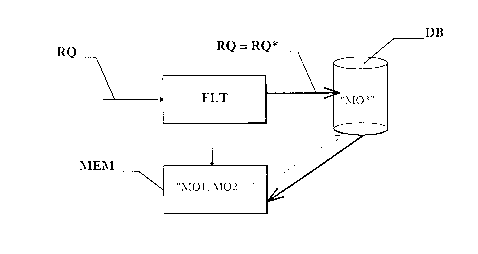Une partie des informations de ce site Web a été fournie par des sources externes. Le gouvernement du Canada n'assume aucune responsabilité concernant la précision, l'actualité ou la fiabilité des informations fournies par les sources externes. Les utilisateurs qui désirent employer cette information devraient consulter directement la source des informations. Le contenu fourni par les sources externes n'est pas assujetti aux exigences sur les langues officielles, la protection des renseignements personnels et l'accessibilité.
L'apparition de différences dans le texte et l'image des Revendications et de l'Abrégé dépend du moment auquel le document est publié. Les textes des Revendications et de l'Abrégé sont affichés :
| (12) Demande de brevet: | (11) CA 2274198 |
|---|---|
| (54) Titre français: | GESTION D'UN COMPOSANT DE RESEAU UTILISANT DES OBJETS DE GESTION DANS UN RESEAU DE COMMUNICATIONS NUMERIQUES |
| (54) Titre anglais: | MANAGEMENT OF A NETWORK ELEMENT USING MANAGED OBJECTS IN A DIGITAL COMMUNICATIONS NETWORK |
| Statut: | Réputée abandonnée et au-delà du délai pour le rétablissement - en attente de la réponse à l’avis de communication rejetée |
| (51) Classification internationale des brevets (CIB): |
|
|---|---|
| (72) Inventeurs : |
|
| (73) Titulaires : |
|
| (71) Demandeurs : |
|
| (74) Agent: | ROBIC AGENCE PI S.E.C./ROBIC IP AGENCY LP |
| (74) Co-agent: | |
| (45) Délivré: | |
| (22) Date de dépôt: | 1999-06-09 |
| (41) Mise à la disponibilité du public: | 1999-12-12 |
| Licence disponible: | S.O. |
| Cédé au domaine public: | S.O. |
| (25) Langue des documents déposés: | Anglais |
| Traité de coopération en matière de brevets (PCT): | Non |
|---|
| (30) Données de priorité de la demande: | ||||||
|---|---|---|---|---|---|---|
|
Network elements of a digital communications network,
for example of an SDH network (SDH = Synchronous
Digital Hierarchy), are managed by controllers using
managed objects. To permit fast access to managed
objects, a simple circuit with a controller (FLT), a
database (DB), and a temporary memory (MEM) is
proposed. The controller carries out a method of
managing the network element wherein in response to
requests (RQ), the objects are stored into the memory
and individual objects (MO*) are swapped out to make
room for new data according to predeterminal criteria,
which specify, for example, the maximum residence time
of the object in the memory. At least these objects are
transferred to the database (DB). Only upon reception
of a request (RQ*) for access to an object (MO*) which
is no longer in the memory (MEM) will this object (MO*)
be read from the database and transferred back into the
memory. The controller manages the network element in
response to the requests by accessing the memory and
using the objects stored therein.
Note : Les revendications sont présentées dans la langue officielle dans laquelle elles ont été soumises.
Note : Les descriptions sont présentées dans la langue officielle dans laquelle elles ont été soumises.

2024-08-01 : Dans le cadre de la transition vers les Brevets de nouvelle génération (BNG), la base de données sur les brevets canadiens (BDBC) contient désormais un Historique d'événement plus détaillé, qui reproduit le Journal des événements de notre nouvelle solution interne.
Veuillez noter que les événements débutant par « Inactive : » se réfèrent à des événements qui ne sont plus utilisés dans notre nouvelle solution interne.
Pour une meilleure compréhension de l'état de la demande ou brevet qui figure sur cette page, la rubrique Mise en garde , et les descriptions de Brevet , Historique d'événement , Taxes périodiques et Historique des paiements devraient être consultées.
| Description | Date |
|---|---|
| Inactive : CIB expirée | 2022-01-01 |
| Inactive : CIB expirée | 2022-01-01 |
| Inactive : CIB du SCB | 2022-01-01 |
| Inactive : CIB de MCD | 2006-03-12 |
| Le délai pour l'annulation est expiré | 2003-06-09 |
| Demande non rétablie avant l'échéance | 2003-06-09 |
| Réputée abandonnée - omission de répondre à un avis sur les taxes pour le maintien en état | 2002-06-10 |
| Inactive : Page couverture publiée | 1999-12-12 |
| Demande publiée (accessible au public) | 1999-12-12 |
| Inactive : CIB attribuée | 1999-08-02 |
| Inactive : CIB en 1re position | 1999-08-02 |
| Inactive : Certificat de dépôt - Sans RE (Anglais) | 1999-07-22 |
| Lettre envoyée | 1999-07-14 |
| Inactive : Certificat de dépôt - Sans RE (Anglais) | 1999-07-14 |
| Demande reçue - nationale ordinaire | 1999-07-12 |
| Date d'abandonnement | Raison | Date de rétablissement |
|---|---|---|
| 2002-06-10 |
Le dernier paiement a été reçu le 2001-06-01
Avis : Si le paiement en totalité n'a pas été reçu au plus tard à la date indiquée, une taxe supplémentaire peut être imposée, soit une des taxes suivantes :
Les taxes sur les brevets sont ajustées au 1er janvier de chaque année. Les montants ci-dessus sont les montants actuels s'ils sont reçus au plus tard le 31 décembre de l'année en cours.
Veuillez vous référer à la page web des
taxes sur les brevets
de l'OPIC pour voir tous les montants actuels des taxes.
| Type de taxes | Anniversaire | Échéance | Date payée |
|---|---|---|---|
| Enregistrement d'un document | 1999-06-09 | ||
| Taxe pour le dépôt - générale | 1999-06-09 | ||
| TM (demande, 2e anniv.) - générale | 02 | 2001-06-11 | 2001-06-01 |
Les titulaires actuels et antérieures au dossier sont affichés en ordre alphabétique.
| Titulaires actuels au dossier |
|---|
| ALCATEL |
| Titulaires antérieures au dossier |
|---|
| JORG SCHABERNACK |
| MONIKA BANZHAF |